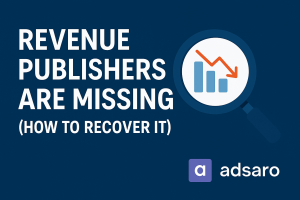Programmatic advertising has revolutionized digital marketing by automating ad buying. However, as the ecosystem has grown, so have inefficiencies in the supply chain. This is where Supply Path Optimization (SPO) comes in.
SPO is a strategic approach that streamlines ad supply chains, eliminates redundant intermediaries, and ensures advertisers get maximum value for their spend. As programmatic advertising becomes increasingly complex, advertisers and publishers must adopt SPO to improve efficiency, transparency, and return on investment (ROI).
This blog will explore what SPO is, why it matters, and how it benefits advertisers, publishers, and the overall ad ecosystem.
What Is Supply Path Optimization (SPO)?
Supply Path Optimization (SPO) is a method used by advertisers and demand-side platforms (DSPs) to analyze and optimize the path between ad inventory sources and advertisers. The goal is to eliminate unnecessary intermediaries and ensure that media buyers access high-quality impressions at the best price.
How SPO Works
SPO works by evaluating multiple supply paths and selecting the most efficient, transparent, and cost-effective route. This involves:
- Identifying and removing redundant resellers that inflate costs without adding value.
- Prioritizing direct publisher relationships over long and opaque supply chains.
- Assessing supply partners based on factors like cost efficiency, transparency, and bid duplication.
- Ensuring quality control by selecting SSPs (Supply-Side Platforms) that provide viewable and fraud-free impressions.
Why Is Supply Path Optimization (SPO) Important?
The programmatic ecosystem is full of middlemen, which can lead to higher costs, lack of transparency, and inefficiencies. Here’s why SPO is critical:
1. Reduces Ad Tech Tax
Every intermediary in the ad supply chain takes a cut from the advertiser’s budget, reducing the actual amount spent on reaching the audience. SPO helps advertisers minimize unnecessary fees and maximize media spend.
2. Improves Transparency
A long supply chain can obscure where ad dollars are going. SPO enables advertisers to see and choose the most direct, cost-efficient paths to inventory.
3. Enhances Ad Performance
By reducing inefficiencies, SPO ensures that ad impressions are served through premium, high-performing sources, leading to better engagement and conversion rates.
4. Prevents Bid Duplication
Some SSPs send the same ad inventory to multiple exchanges, resulting in bid duplication. SPO helps eliminate redundant bidding, preventing advertisers from overpaying.
5. Strengthens Fraud Prevention
A cluttered supply chain increases the risk of ad fraud and invalid traffic. SPO helps advertisers work with trusted partners like DoubleVerify, Integral Ad Science (IAS), and Moat by Oracle, which provide fraud detection and brand safety solutions. By using SPO, advertisers can reduce exposure to fraud and ensure more efficient ad spend.
How Advertisers Benefit from Supply Path Optimization
For advertisers, SPO is a game-changer in ensuring cost-effective, transparent, and high-quality ad placements. The benefits include:
- Lower CPMs (Cost per Thousand Impressions): Advertisers pay less by avoiding redundant resellers.
- More Control Over Ad Spend: With fewer intermediaries, advertisers can allocate their budgets more efficiently.
- Higher Viewability & Engagement: Ads reach premium publishers, increasing their effectiveness.
- Better Data Insights: Advertisers gain clearer visibility into where their ads are placed.
How Publishers Benefit from SPO
Publishers also benefit from SPO as it helps them strengthen direct relationships with advertisers and maximize revenue:
- Higher Revenue Share: Publishers keep more of the ad spend when unnecessary middlemen are removed.
- Improved Buyer Trust: Transparency fosters better relationships with advertisers.
- More Efficient Monetization: Direct deals lead to higher fill rates and better yields.
Best Practices for Implementing SPO
To make the most of Supply Path Optimization, advertisers should follow these key strategies:
1. Partner with Fewer, High-Quality SSPs
Rather than spreading budgets across multiple exchanges, advertisers should work with a select few SSPs that provide transparency and efficiency.
2. Leverage First-Party Data
Using first-party data ensures that advertisers target the right audience without relying on inefficient supply paths.
3. Monitor and Evaluate Supply Paths Regularly
Advertisers must continuously analyze their supply paths, eliminating any that introduce unnecessary costs or inefficiencies.
4. Prioritize Direct Deals
By working directly with publishers through programmatic direct or private marketplaces (PMPs), advertisers can ensure better pricing and transparency.
The Future of SPO in Programmatic Advertising
As the industry shifts towards privacy-first advertising and cookie-free targeting, SPO will become even more essential. Trends shaping the future of SPO include:
- AI-Driven Optimization: Artificial intelligence will automate and refine supply path selection.
- Greater Focus on Sustainability: Reducing bid duplication and unnecessary tech tax will lead to more eco-friendly advertising.
- Increased Transparency Standards: Industry-wide initiatives will push for cleaner, more direct supply paths.
Conclusion
Supply Path Optimization (SPO) is a vital strategy in improving programmatic advertising efficiency, reducing costs, and enhancing transparency. By eliminating redundant resellers, reducing bid duplication, and strengthening direct partnerships, SPO empowers advertisers to get the best value for their ad spend.
As programmatic advertising continues to evolve, SPO will play a crucial role in shaping a more transparent and cost-effective ecosystem. Advertisers and publishers that prioritize SPO today will stay ahead in the digital advertising landscape.








Leave a Reply